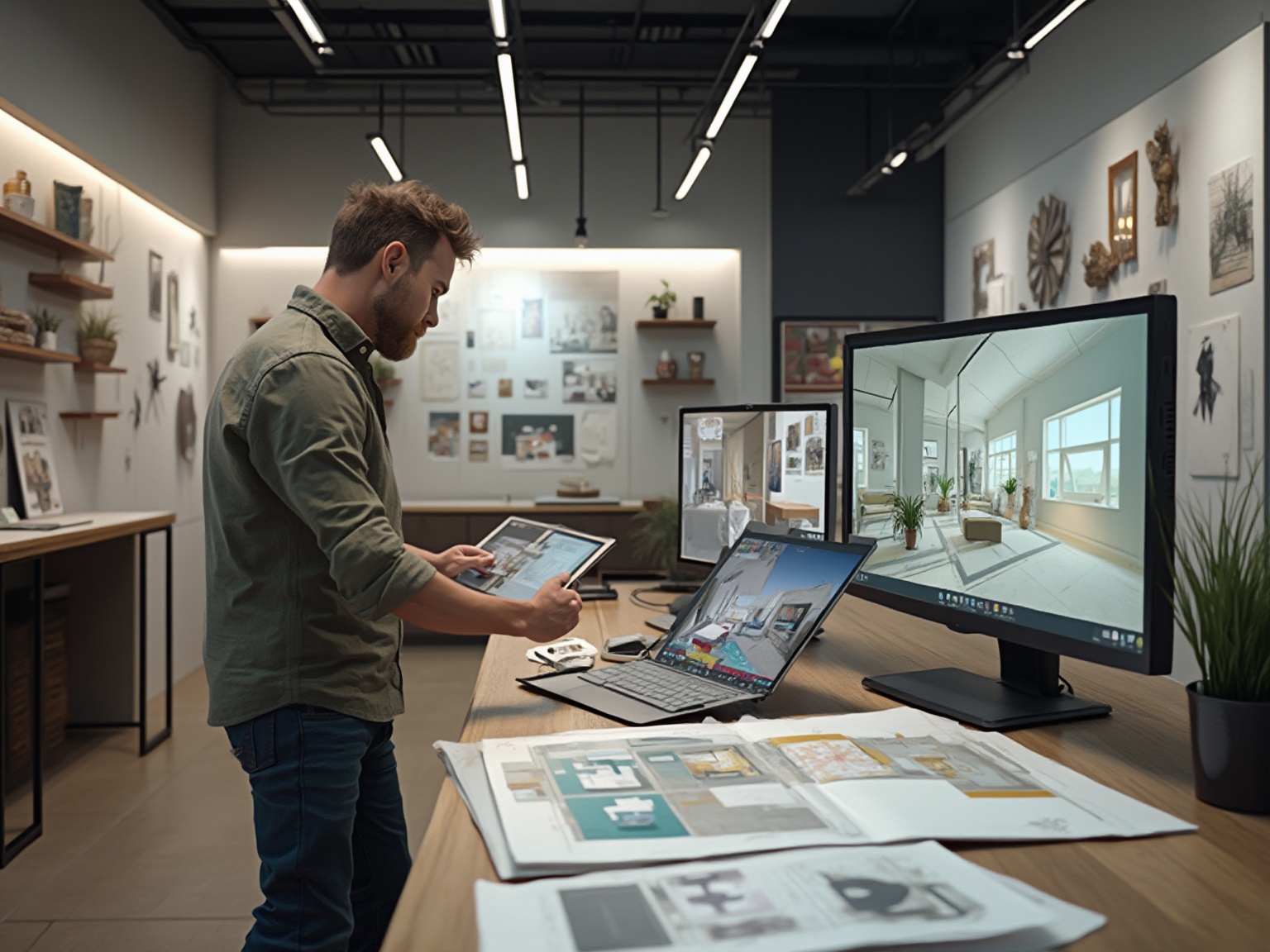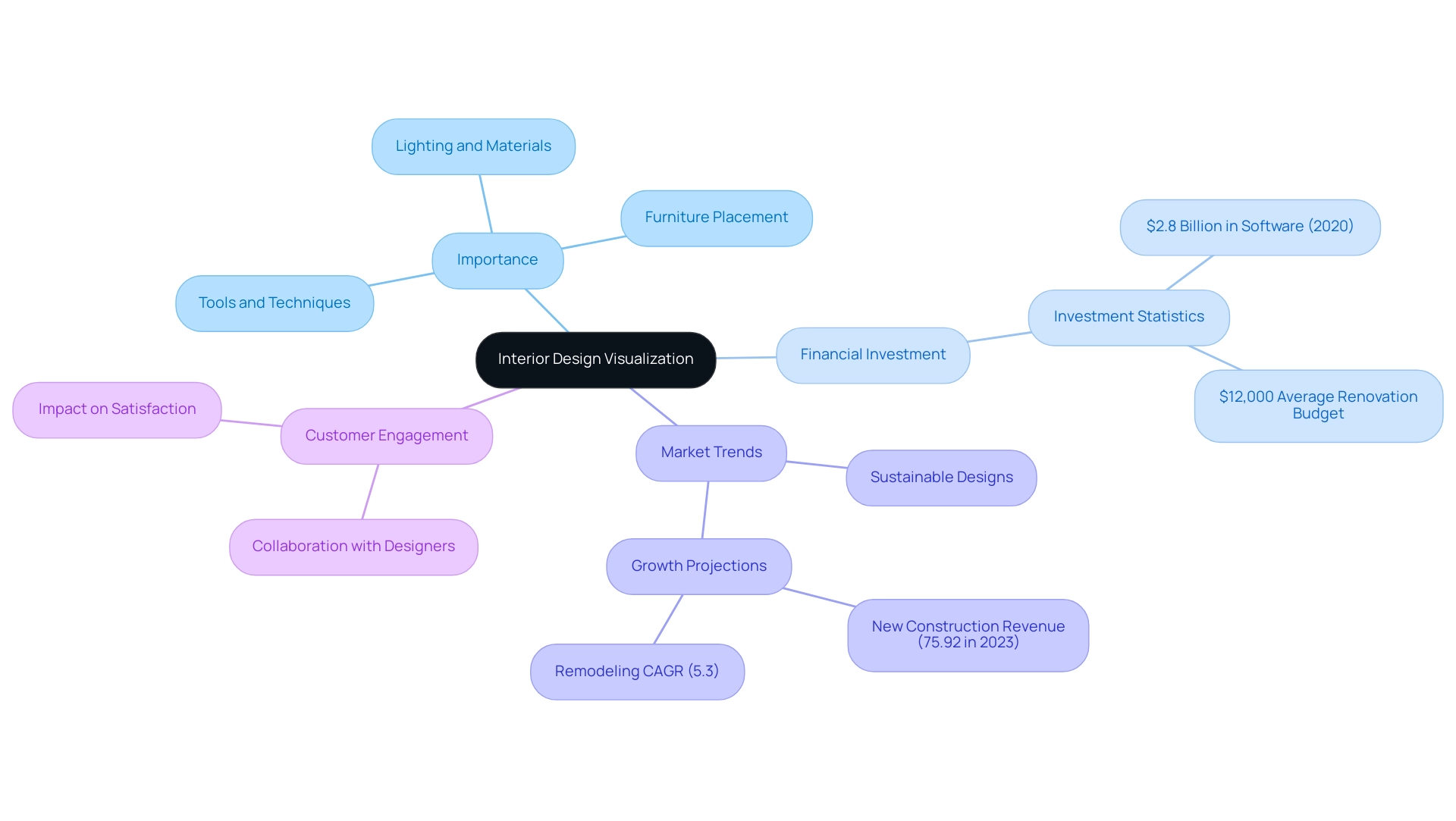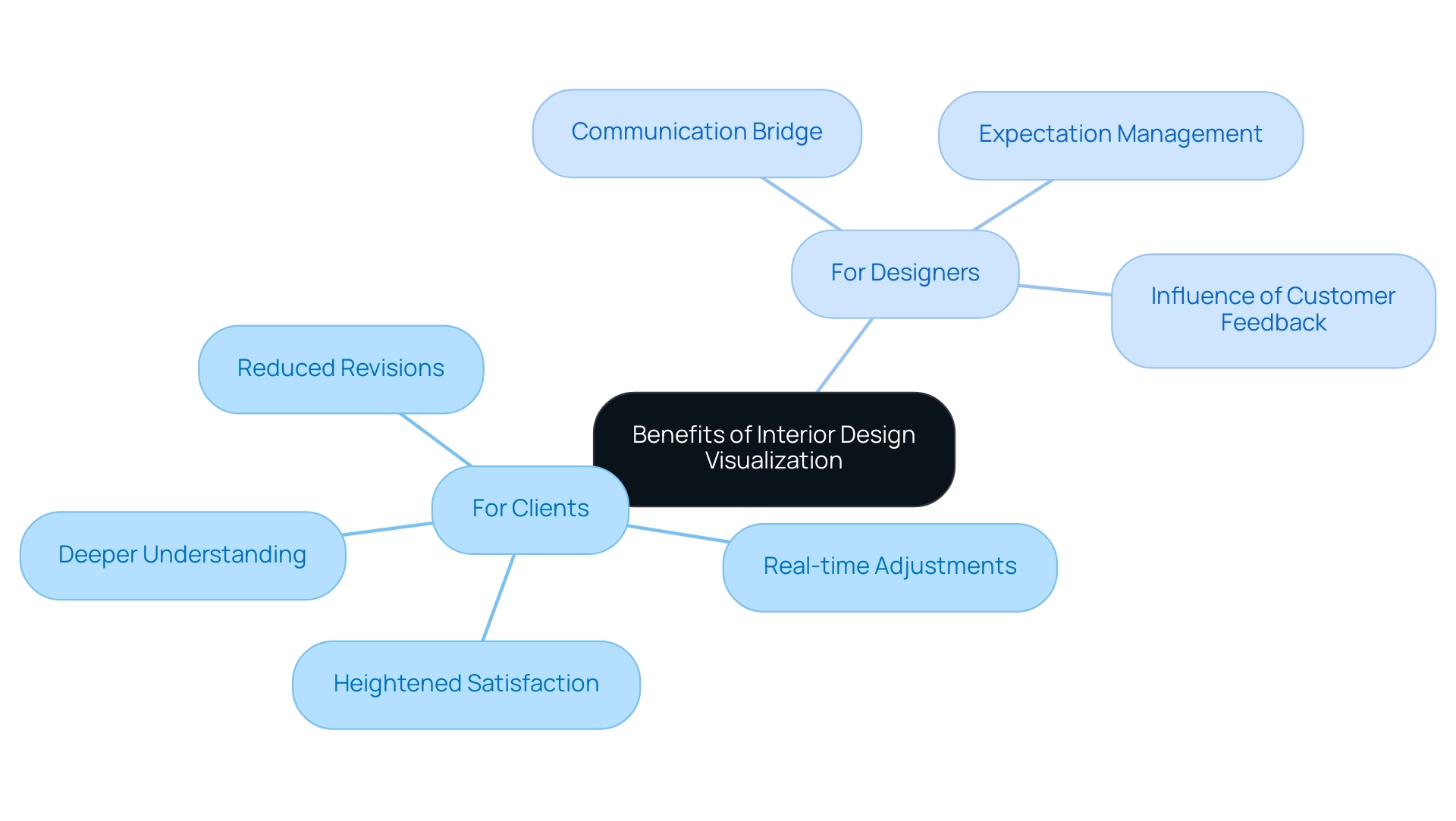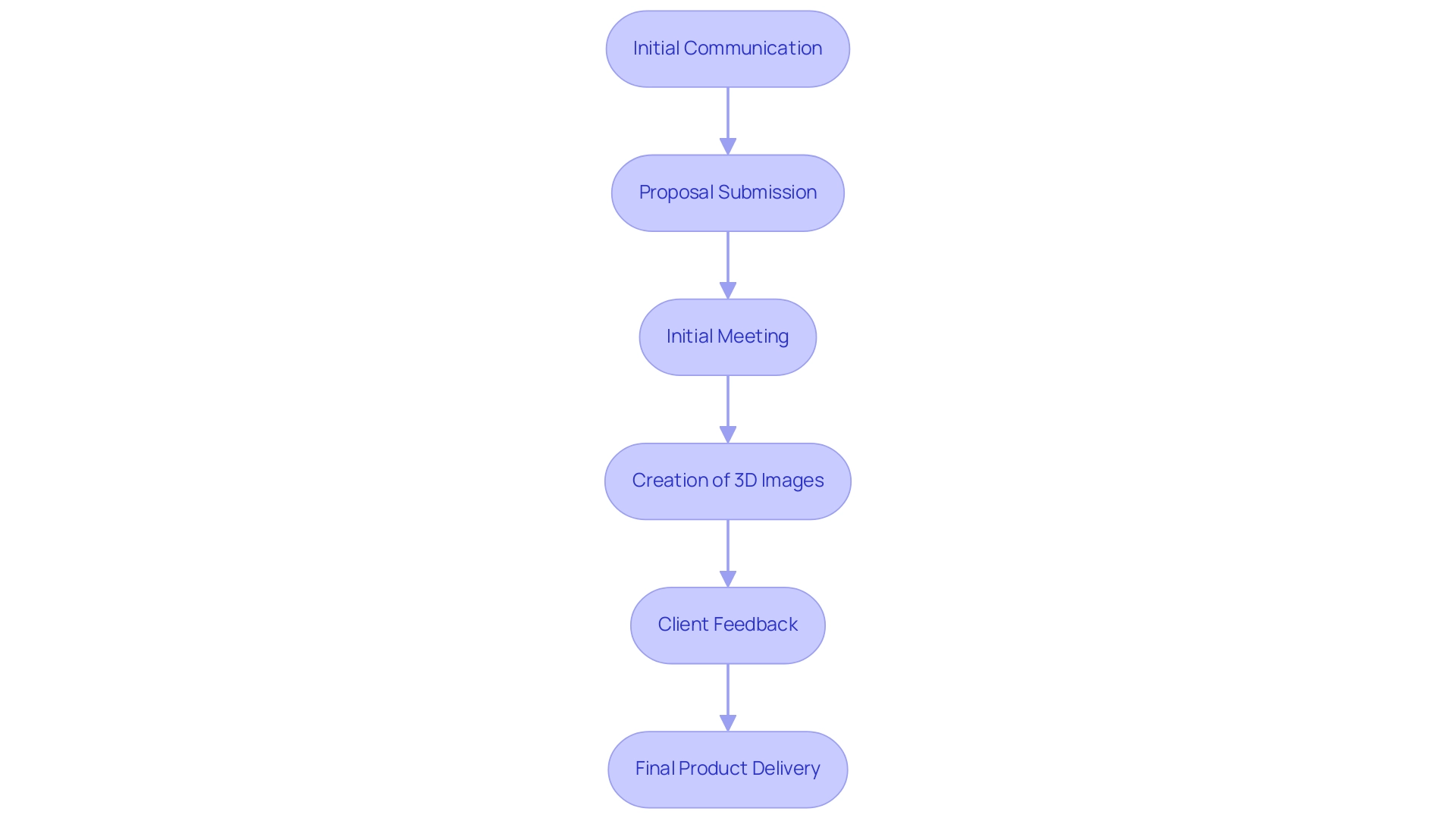Overview
Interior design visualization is crucial for modern homes as it enables designers and clients to create digital representations of spaces, facilitating informed decision-making and enhancing project outcomes. The article underscores its importance by detailing how visualization tools improve communication, reduce revisions, and align customer expectations, ultimately leading to higher satisfaction and more effective design processes.
Introduction
In the realm of contemporary architecture, the integration of interior design visualization has emerged as a critical necessity, reshaping the way spaces are conceived and realized. This innovative practice involves the use of advanced digital tools to create immersive representations of interior environments, allowing both designers and clients to engage in a collaborative dialogue before construction begins.
By capturing essential elements such as:
- Lighting
- Materials
- Spatial dynamics
these visualizations not only enhance aesthetic appeal but also optimize functionality, paving the way for informed decision-making. As the industry continues to evolve, the reliance on sophisticated visualization techniques is becoming increasingly evident, driven by a growing demand for personalized and sustainable designs.
This article delves into the multifaceted benefits of interior design visualization, the essential tools that facilitate this process, the challenges faced in implementation, and the emerging trends that promise to redefine the future of design practices.
Defining Interior Design Visualization: A Modern Necessity
The importance of Interior design visualization for modern homes is highlighted by its role in creating digital representations of interior spaces using advanced tools and techniques, making it an essential component of contemporary architecture and design. This practice underscores the importance of Interior design visualization for modern homes by allowing designers and clients to visualize concepts prior to construction, which enables more informed and effective decision-making. Key elements such as lighting, materials, textures, and furniture placement play a crucial role in creating impactful 3D visuals that not only enhance aesthetic appeal but also optimize the functionality of a space.
For example, while artificial lighting is essential in interior visuals, accurately illustrating how light fixtures brighten the area and the interaction with natural light is crucial for attaining a well-balanced composition. The integration of detailed furniture models adds an extra layer of realism to the visuals, showcasing how spaces can be effectively utilized. The incorporation of 3D visuals emphasizes the importance of interior design visualization for modern homes, as it aids in clear communication of concepts and examination of alternatives, ultimately ensuring that endeavors align with both customer expectations and industry standards.
Notably, architecture firms in the U.S. invested over $2.8 billion on software and technology in 2020, reflecting the industry’s commitment to leveraging these digital tools. Furthermore, with high-income households allocating an average budget of $12,000 for interior renovations, as noted by Jennifer Davenport, the importance of interior design visualization for modern homes becomes increasingly evident. As we look towards 2024, the latest trends indicate the importance of interior design visualization for modern homes, reflecting a growing reliance on these tools to foster collaboration between designers and their customers, ensuring that projects not only meet but exceed expectations.
This evolution in creative practices is poised to significantly affect customer satisfaction and engagement. Additionally, the new construction segment accounted for 75.92% of revenue in 2023, driven by a demand for personalized and modern interiors, while remodeling is projected to grow at a CAGR of 5.3%. Both segments are concentrating on sustainable and energy-efficient concepts to satisfy consumer demands for updated and functional areas.
The Benefits of Interior Design Visualization for Clients and Designers
The importance of Interior design visualization for modern homes provides a multitude of benefits for both customers and designers, fundamentally transforming the design process. For customers, these visual tools promote a deeper understanding and engagement with proposed changes, allowing for real-time adjustments before construction begins. This proactive involvement not only leads to heightened satisfaction but also significantly reduces the need for revisions, aligning with the average budget of $12,000 allocated by high-income households for interior renovations, as reported by Wealth Management Magazine.
Moreover, the importance of Interior design visualization for modern homes is highlighted as visualization tools assist users in understanding project timelines, costs, and outcomes, providing clarity and fostering confidence in the project’s direction. For designers, these tools emphasize the importance of Interior design visualization for modern homes, acting as an essential communication bridge to ensure that expectations—refined through collaborative planning and feedback—are clearly defined and met. Significantly, case studies from J. Scott Smith Visual Designs demonstrate how thorough conversations with customers regarding their visions and needs influence the creation process, directly affecting satisfaction and marketing effectiveness.
For instance, one client remarked, ‘The collaborative approach made me feel heard and understood, and the final renderings exceeded my expectations.’ This alignment enhances the overall aesthetic experience and underscores the importance of Interior design visualization for modern homes by minimizing the potential for expensive modifications during the construction phase. Furthermore, as the interior decoration industry continues to thrive, with 120,000 professionals employed in the U.S. as of 2024, the importance of interior design visualization for modern homes becomes increasingly vital.
The importance of customer testimonials cannot be overstated; they reflect the dedication to exceeding expectations and guide future projects. By customizing concepts based on input, such as another customer stating, ‘The process was seamless, and I felt involved every step of the way,’ creators can ensure that expectations are met, ultimately leading to a more streamlined process and a superior final outcome that benefits all stakeholders involved.
Essential Tools and Technologies in Interior Design Visualization
The importance of interior design visualization for modern homes is evident as several essential tools and technologies play a crucial role in elevating the creative process while enhancing contractor communication and customer understanding. Computer-Aided Design (CAD) software remains fundamental, enabling designers to create precise floor plans and layouts that serve as the backbone of any project. Its accessibility allows a broader range of designers to leverage CAD capabilities effectively, ensuring that all stakeholders are aligned.
Complementing CAD are advanced 3D modeling applications, which facilitate the creation of realistic representations of spaces, including intricate textures and dynamic lighting effects. These visual representations underscore the importance of interior design visualization for modern homes, as they not only assist in removing misunderstandings but also eliminate uncertainty in planning, allowing customers to view an engaging preview of the completed structure, clarifying intentions for contractors. Furthermore, Virtual Reality (VR) technology elevates visualization to unparalleled heights, immersing users in a virtual environment that offers a genuine sense of scale and spatial relationships.
Notably, software like Adobe Express offers various options for designers looking to enhance their visualization capabilities, from a free version to a Premium membership for $10 per month. By utilizing Adobe Express, creators can produce effective renderings that clearly convey concepts, further enhancing contractor communication. Additionally, Revit stands out as a professional tool that supports Building Information Modeling (BIM), emphasizing the importance of interior design visualization for modern homes by facilitating collaboration and creating detailed architectural and interior models.
A case study on CAD platforms highlights their comprehensive editing tools and file format options for sharing creations, ensuring that users can maintain accuracy and collaborate effectively with colleagues and customers. These integrated tools not only enhance precision but also significantly improve the overall presentation, illustrating the importance of interior design visualization for modern homes by empowering customers to visualize the final outcome with clarity and confidence. As advancements in these technologies continue to evolve, they remain essential for maintaining competitiveness in the ever-changing architecture, engineering, and construction (AEC) industry.
Challenges in Implementing Interior Design Visualization
The implementation of interior visualization presents a range of challenges that must be navigated effectively, particularly in the context of outsourcing 3D architectural rendering services. Smaller firms often struggle with the high initial costs associated with software and hardware, which can impede their ability to adopt these technologies. A significant 8.8% of firms utilize a combination of in-house and outsourced services, reflecting diverse strategies to manage these costs.
The technical requirements for operating advanced visualization tools necessitate specialized training, placing further demands on limited resources. Moreover, customer resistance, especially from those unfamiliar with contemporary visualization techniques or who favor traditional approaches, can pose substantial hurdles. To address these challenges, it is essential for designers to prioritize investment in training programs that enhance proficiency with these tools.
Communicating the importance of interior design visualization for modern homes, including long-term benefits such as improved accuracy, enhanced client engagement, and the ability to showcase designs compellingly, will facilitate a smoother transition toward modern design practices. Additionally, ensuring data integrity is vital for uncovering authentic insights and trends that drive business success, as misleading visualizations can lead to poor decision-making. A case study titled ‘The Role of Data Reliability’ illustrates that accurate data is essential for revealing true findings, underscoring the argument for prioritizing data integrity in the visualization process.
By effectively overcoming these challenges, firms can leverage the importance of interior design visualization for modern homes to enhance property value, improve the buyer experience through immersive exploration, and differentiate their market offerings. Furthermore, outsourcing 3D architectural visualization services can provide businesses with access to advanced technologies and expertise without the burden of high upfront costs. This strategic method enables companies to concentrate on their core strengths while gaining from high-quality visual representations that can draw in customers and enhance results.
Testimonials from pleased customers emphasize the transformative effect of our services, demonstrating how impactful 3D visuals have resulted in successful project completions and increased customer satisfaction.
Future Trends in Interior Design Visualization: Embracing Innovation
The landscape of interior design visualization for modern homes is undergoing a remarkable transformation, driven by the collaborative rendering process at J. Scott Smith Visual Designs. This process begins with initial communication, where our virtual assistant engages with clients to answer basic questions 24/7, while any other inquiries are welcomed via telephone or email. We first learn of your initiative when you submit it for a proposal through our web portal.
Following this, we have an initial meeting to understand your unique vision and specifications. Our premium 3D images demonstrate the importance of interior design visualization for modern homes, serving as an essential gateway into the future of your endeavor and enabling all stakeholders to envision the possibilities and make informed choices. Customization and revisions play a vital role in tailoring our services to meet the specific needs of each assignment, ensuring that the final product exceeds expectations.
Our talented artists carefully create intricate models that embody the design intent, while our dedication to client satisfaction is clear through ongoing interaction and feedback during the production process. For instance, we typically start by creating your fundamental design and sending you clay visuals, which display our advancement and enable your initial input. Investing in impressive 3D visualizations underscores the importance of interior design visualization for modern homes, as it not only enhances architectural vision but also significantly influences development and decision-making.
According to McKinsey & Company, the implementation of advanced visualization technologies has resulted in shortened timelines and heightened productivity, demonstrating the importance of interior design visualization for modern homes in achieving successful results. The complexities and scale of each undertaking influence rendering time and resource requirements, reinforcing the need for effective communication and collaboration at every stage. As we continue to innovate and adapt to the evolving landscape of interior design, our focus remains on delivering exceptional results that resonate with clients and elevate their projects.
Conclusion
The exploration of interior design visualization reveals its pivotal role in modern architecture, underscoring the necessity of advanced digital tools in the design process. By enabling designers and clients to collaboratively visualize concepts, this practice not only enhances aesthetic appeal but also fosters informed decision-making. Key elements such as lighting, materials, and spatial dynamics have been shown to significantly influence both functionality and emotional resonance within a space, ultimately leading to higher client satisfaction.
The multifaceted benefits outlined demonstrate how effective visualization tools facilitate deeper client engagement and streamline the design process. By minimizing revisions and aligning client expectations with designer intentions, these tools contribute to a more efficient workflow, resulting in superior project outcomes. The integration of technologies like CAD, 3D modeling, and Virtual Reality further enhances communication and understanding among all stakeholders, marking a significant advancement in the industry.
However, challenges remain in implementing these sophisticated tools, particularly for smaller firms. High costs, technical training requirements, and client resistance can hinder adoption. Addressing these challenges through investment in training and clear communication of the long-term benefits of visualization is essential for firms looking to remain competitive in a rapidly evolving market.
Looking ahead, the future of interior design visualization is characterized by innovation and collaboration. As the industry adapts to new technologies and methodologies, the emphasis on tailored, high-quality renderings will continue to shape project development and client interactions. By embracing these advancements, architects and designers can ensure that their practices not only meet but exceed the expectations of an increasingly discerning clientele.






0 Comments